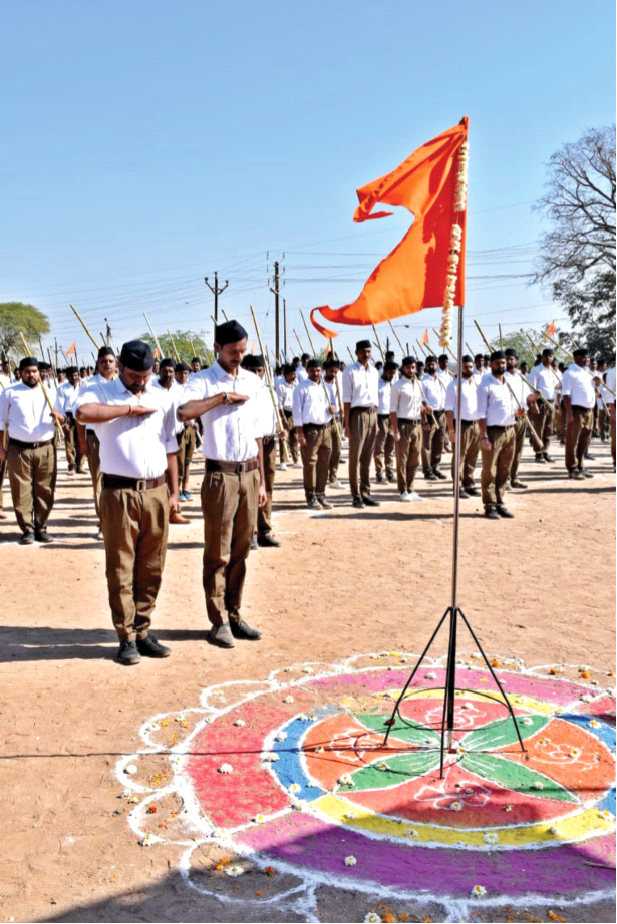When the Rashtriya Swayamsevak Sangh (RSS) was started, several Swayamsevaks wanted its founder Dr Keshav Baliram Hedgewar to be designated as the ‘Guru’, as he was the most revered figure amongst them, and every Swayamsevak looked up to him as an ideal. But Dr Hedgewar decided that the Bhagwa Dhwaj (Saffron Flag) should be the ‘Guru’. Every year, on the day of ‘Vyas Poornima’, according to the Bharatiya Panchang, the Bhagwa Dhwaj is formally worshipped.
The RSS organised the first Gurupuja in 1928, where the Bhagwa Dhwaj was formally worshipped as the Guru. Since then, there has been no break in this tradition, and the Bhagwa Dhwaj continues to occupy the highest pedestal in the RSS hierarchy. Why is Bhagwa Dhwaj treated as the Guru or the Supreme by the RSS? The question has baffled many as there has been a general tradition that many spiritual and religious institutions and organisations have had their founders as the Guru, and they are worshipped by the followers. In the rich Indian tradition of the Bhakti movement and even in the contemporary era, there is no dearth of individuals treated as the Guru. In fact, the decision to have the Bhagwa Dhwaj as the Guru is a unique move, even if one goes into recent world history. A Bhagwa Dhwaj being the ultimate master in a mammoth organisation that could be called one of the largest voluntary organisations in the world is worth pondering upon. Many in the RSS have tried to explain this interesting aspect of the organisation.
According to RSS ideologue HV Seshadri, “Bhagwa Dhwaj has been a venerated symbol of the national culture and tradition of Bharat (ancient name of India) since ages. When Hedgewar started the Sangh, he placed the Bhagwa before all Swayamsevaks as the supreme symbol of all national ideals. He eulogised it as the Guru and established the tradition of Gurupuja on the Vyaspoornima day.
N H Palkar, Karyavah of the RSS in Maharashtra, wrote an interesting book exclusively on the Bhagwa Dhwaj of the RSS. The book was originally written in Marathi and got published in 1958. A Hindi translation of the same was later reproduced. This 76-page book examines the origin of the Bhagwa Dhwaj and dates it back to the Vedic period. Palkar says, “The Bhagwa Dhwaj has always been respected in the Hindu social life…it finds mention in Vedic literature as ‘Arunketu’.” He further adds that the Bhagwa Dhwaj has been a source of inspiration to get up and fight back for the Hindus whenever they faced attacks by the foreigners. It was used as a well-planned measure to motivate Hindus to fight back and protect the nation. The most important tenet which guides the RSS philosophy regarding treating Bhagwa Dhwaj or the Bhagwa Dhwaj as its Guru is that an individual can fall from grace or may have some weaknesses, but the Bhagwa Dhwaj can’t. It is apparent that the decision to choose Bhagwa Dhwaj as the Guru in RSS was taken primarily due to three reasons: First, to make an organisation stand unitedly and grow, a flag remains historically one of the most potent means.
Bhagwa Dhwaj Second, cultural nationalism, which is one of the key building blocks of the RSS’ philosophy, finds its most comprehensive reflection in the Bhagwa Dhwaj.
Bhagwa Dhwaj Third, the RSS wanted to ensure that it does not become a person-centric organisation by putting a symbol of cultural nationalism at the highest pedestal instead of an individual. There are primarily two reasons for organising the Gurudakshina programme. First, to carry forward the age-old revered tradition of the Guru-Shishya (Master-Disciple)’ tradition of ancient India. And second, to arrange finance for the functioning of the organisation.
Students used to stay in the ashrams of saints in ancient India and on completion of their education and training, used to offer dakshina, as a mark of respect for the Master. In the Hindu tradition, the value of ‘offering’ did not matter; what really mattered was the sense of gratitude with which the Dakshina, was given. The teachers used to accept whatever was offered with an equal sense of contentment. This sacred tradition was revived by the RSS in modern times in its Shakha, right since its inception and is performed to date.









![A Representative image [ANI Photo]](https://organiser.org/wp-content/uploads/2025/12/representative-image-e1765612818961-120x70.webp)









Comments